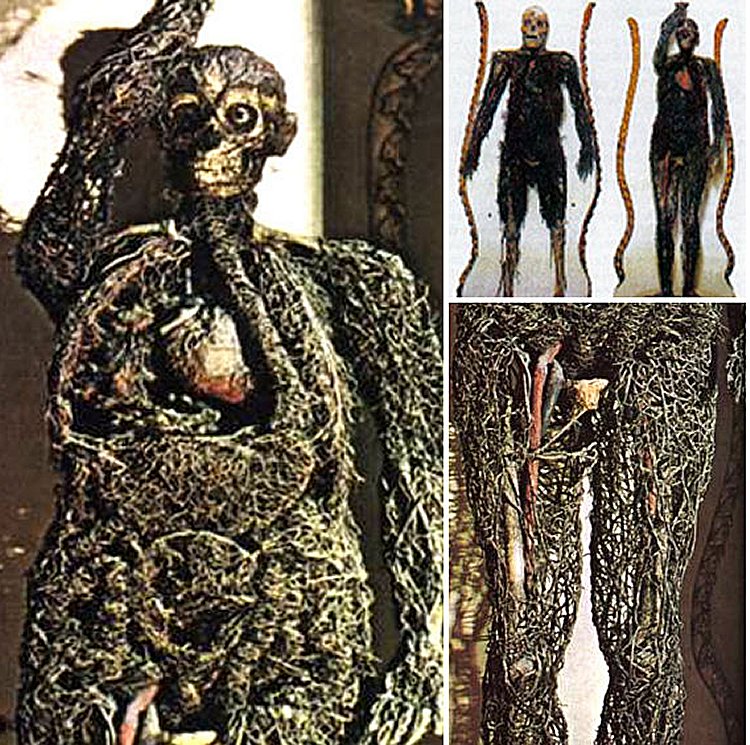MessageToEagle.com – The so-called ‘Anatomical Machines’ are preserved in the underground crypt of the Sanseveri Chapel, located in the historic center of Naples, Italy.
The ‘Anatomical Machines’ are the skeletons of a man and of a woman in upright position with the artery and vein systems almost perfectly intact.
Still today, after about two-and-a-half centuries, it is still a mystery what procedures and/or materials were used to obtain such an exceptional preservation of the circulatory system.

Stored in two glass cases, the pair represents one of the most impressive monuments that the human mind has ever conceived.
The ‘Machines’ were made by the doctor Giuseppe Salerno, an anatomist from Palermo, Italy under the direction of Raimondo di Sangro, Prince of Sansevero (1710-1771), alchemist and Grand Master of Neapolitan Masonic Lodge, philosopher and poet, naturalist and anatomist, astronomer, philanthropist.

Was a technique known as ‘anatomical injection of embalming substances’, a part of this mysterious procedure?
It is said that Dr. Salerno injected a substance – perhaps based on mercury – into the two corpses.
The substance would have been created in a laboratory by the Prince of Sansevero and would allow the “metallization” of the blood vessels.
There is also another suggestion, namely, that the circulatory system was ingeniously reconstructed in these two amazing anatomical ‘machines’.
In fact, the arteries and veins are reproduced with remarkable perfection, even the smallest vessels, despite the fact that knowledge of anatomy was not as precise as it is today.
In the ‘Short Note’, the ‘machines’ – kept in a room in the palace of the Prince of Sansevero, called “the Apartment of the Phoenix” – are described in detail.
At the feet of the woman, the guide states, there was placed “the tiny body of a foetus”, alongside which there was even the open placenta, connected to the foetus by umbilical cord.
Some of the vital organs are present but also seem misplaced. Although, the organs were not sampled, visual examination suggests that they may have been made with a core of wood which was coated with wax.
The two anatomical studies were moved to the Chapel, and in this way saved from destruction or loss, long after the death of the Prince.
The remains of the foetus were still visible up to a few decades ago, until they were stolen. According to popular belief, Raimondo di Sangro “had two of his servants killed”, a man and a woman, and embalmed their bodies.
In Greek mythology, Phoenix – a long-lived bird that is cyclically regenerated or reborn – gives the association with the myth of resurrection and immortality.
Were these fleshless bodies the objects of di Sangro’s studies? He was often portrayed as a ‘misunderstood man, who was ahead of his time.
Was the ‘Apartment of the Phoenix’ used intentionally or was the name ‘Phoenix’ chosen accidentally?
These questions may seem rather difficult to answer and due to lack of written documentation on the early history of the anatomical machines, the mystery will probably never be solved.
See also:
- Did Our Ancestors Know About Artificial Intelligence?
- Middle Ages’ Great Event – Rocket Launch Into Space At Sibiu, Romania Took Place in 1555
- Prehistoric Heavy Machinery Of The Ancient Times Or Just A Piece Of Jewellery?
Until recently many Neapolitans believed that the models were of his servant and a pregnant woman, into whose veins an artificial substance was injected under pressure, but the latest research has shown that the models are artificial.
No evidence was found to indicate that the vessels of the cadavers used to make the ‘human machines’ were injected with embalming substances.
Di Sangro destroyed his own scientific archive before he died. After his death, his writings, formulae, laboratory equipment and results of experiments were destroyed, probably under threat of excommunication by the Church due to Di Sangro’s involvement with Freemasonry and alchemy.
Copyright © MessageToEagle.com. All rights reserved. This material may not be published, broadcast, rewritten or redistributed in whole or part without the express written permission of MessageToEagle.com
Expand for references






